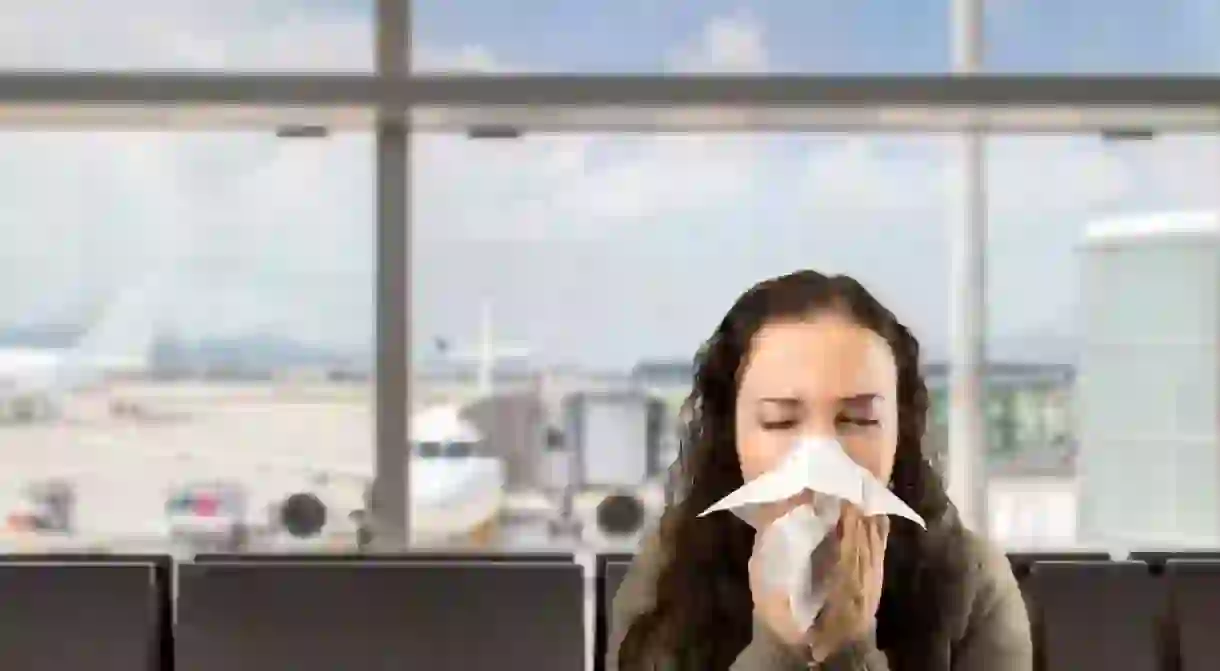These Are the Grossest Parts of an Aeroplane Cabin. Here's How to Avoid Getting Sick While You Travel

We all know that planes aren’t the most sanitary of places.
With hundreds of people eating, sleeping and using the toilet in a tightly sealed metal tube every day, germs are bound to spread.
But whereabouts are the places that have the most germs?
If you know where the most unhygienic spots are, you can make sure that you avoid them.

Thanks to Travelmath, we know that the dirtiest places are tray tables, lavatory flush buttons, overhead air vents and seat belt buckles – all items you touch with your hands multiple times during the course of a long flight.
They sent microbiologists to collect 26 samples from four flights to discover where the most germs are. They then analysed the number of bacteria in colony-forming units (CFU) per square inch.
The team found that tray tables had 2,155 CFU per square inch, toilet flush buttons had 265 CFU per square inch, air vents had 285 CFU per square inch and seat belt buckles had 230 CFU per square inch.
The report stated that the high numbers of germs were probably due to the short turnaround time between flights, which leave airline staff with no time to disinfect each individual seat area.

To make matters worse, Dr Charles Gerba, a University of Arizona microbiologist, told TIME that the trays he’s tested have had cold and flu viruses and norovirus on them – all of which cause unpleasant symptoms such as diarrhoea and vomiting. He also found the superbug MRSA, which causes skin infections.
The high numbers of germs comes from the large amount of people constantly moving through planes and airports, says James Barbaree from the Detection & Food Safety Centre of Auburn University in Alabama.
He said: ‘All of us carry microbes on our skin, clothes, and inside our bodies. Some of these microbes are transmitted to other humans, and bacteria multiply in unclean areas.’
As if that wasn’t bad enough, it’s been established that you’re more likely to get ill on planes regardless, due to the air quality.

The air humidity in a plane cabin is under 20%, whereas average air humidity in a home is normally over 30%, says the World Health Organisation. This dry air affects mucus production, which is the immune system’s first line of defence against illness.
In 2004, a study in the Journal of Environmental Health Research discovered that people can be up to 113 times more likely to catch the common cold during a flight than they are in a normal environment.
If all this is making you vow never to set foot on a plane again, don’t worry. There are measures you can take that will help to stop you getting sick.
Firstly, there’s no point letting this unduly worry you. There are germs everywhere we go, after all, and if you find yourself obsessively worrying about getting ill while travelling, it could be worth telling a health professional about your worries to find some strategies that make you feel more in control.
Carry hand sanitiser with you while you travel, and use it whenever you’ve touched something that lots of other people may have touched, such as door handles or that dreaded tray table. It’s also sensible to follow NHS guidelines on avoiding illness. These include not touching your eyes or nose in case you’ve come into contact with the virus and washing your hands frequently with soap and warm water.
You could avoid using the tray table completely, but that’s awkward if you’re on a long flight and can’t rest your full meal tray on your lap. Consider carrying antibacterial wipes and wiping down all surfaces near you, which should give you some peace of mind. Alternatively, make sure that none of your food actually touches the table, resting it instead on paper wrappers or freshly opened napkins.
As for those dirty bathrooms, try wrapping a paper towel over your hand when using the flush and opening the door. This is recommended by Dr Zimring of Baltimore’s Mercy Medical Centre, who says that he never fails to use a hand towel to open the bathroom door – after all, if you’ve just washed your hands, what’s the point in getting them dirty again by touching a handle that tens of other people have used?
Stay clean out there, travellers.













